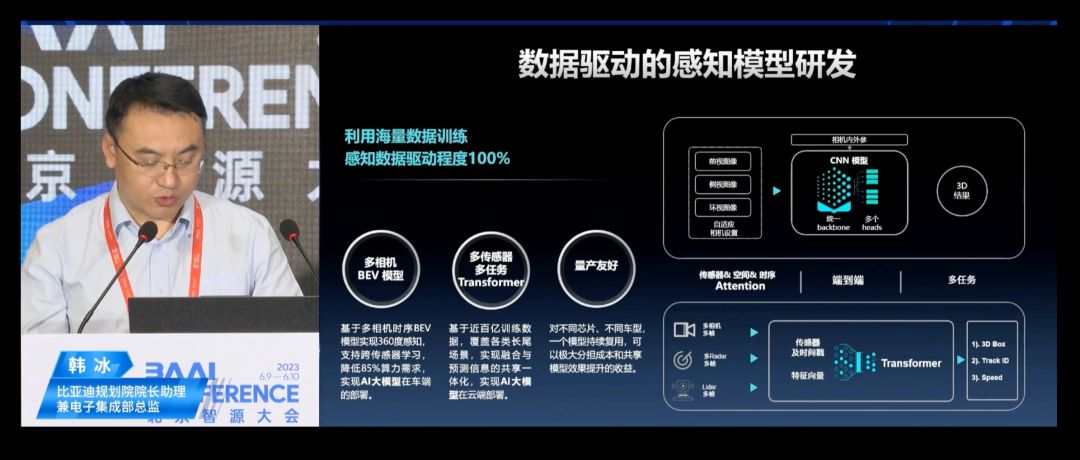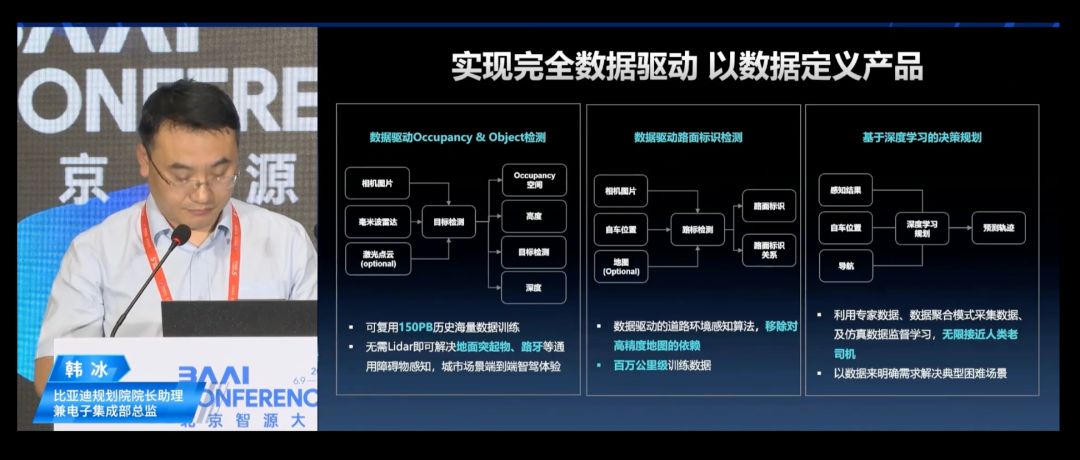Author |
Ma Bo
Editor | Dexin
Not long ago, HiEV exclusively reported BYD's latest mass production plan in the field of intelligent driving.
BYD will launch a high-end intelligent driving solution based on Horizon Journey 5 in the third quarter of this year. The first high-end intelligent driving function is high-speed navigation assisted driving DNP, and the first model is likely to be Han.

Han Bing revealed that BYD has currently established a research and development fleet with more than 300 vehicles.
Editor | Dexin
Not long ago, HiEV exclusively reported BYD's latest mass production plan in the field of intelligent driving.
BYD will launch a high-end intelligent driving solution based on Horizon Journey 5 in the third quarter of this year. The first high-end intelligent driving function is high-speed navigation assisted driving DNP, and the first model is likely to be Han.
Wang Chuanfu has stated on many occasions that the first half of smart electric vehicles is electrification, and the second half is intelligence. Beginning this year, BYD
has accelerated the pace of intelligent
layout .
At the Beijing Zhiyuan Conference last weekend, Han Bing, Assistant Dean of BYD Planning Institute and Director of Electronic Integration Department, revealed the latest progress of BYD's research and development of intelligent driving. This is also the first time that BYD has talked about the path and progress of developing intelligent driving in public.
Han Bing's current role is equivalent to the person in charge of research and development of BYD Zhijia.
Han Bing graduated from RWTH Aachen University in Germany with a master's degree in electrical engineering and information technology. According to 36 Krypton's previous reports, Han worked in Delphi and was engaged in the development of middleware and underlying systems. The electronics integration department he led in the past was mainly responsible for
operating systems, domain controllers, middleware,
etc., but in a recent adjustment, Han Bing's team also integrated the business of intelligent driving algorithms and chip research and development. Han Bing's sharing mainly revolves around the "AI large model".
Han Bing believes that this year's combination of BEV perception and other large-scale model technologies is an opportunity for BYD's high-end intelligent driving to form a
curve overtaking .
In addition, with the combination of smart driving and Yi Sifang platform, BYD is developing some more distinctive advanced driving assistance functions.
1. Data and large models: BEV perception will be launched this year
The application of large models is inseparable from the most critical "data". With big data, it is possible to develop a large model, and at the same time, a large computing power platform layout on the vehicle side is required.
Let's take a look at BYD's progress from the big model, big data, and big computing power.

Han Bing revealed that BYD has currently established a research and development fleet with more than 300 vehicles.
In terms of data, BYD has accumulated
more than 150PB of data
and will add 1PB of data every day. These data are
used for downstream training tasks, and
most of them are automatically labeled, and the labeling automation rate exceeds 95%.
Han Bing predicts that there will be 600 million kilometers of accumulated data this year, and in the next few years, an exponential data reserve will be achieved through research and development of vehicles and mass production fleets to solve the long-tail problem of smart driving.
Data is the base, and the big model is the tool to realize the leap of experience.
Han Bing said that BYD is developing a data-driven model.
At present, BYD's smart driving perception model development has been
100% data-driven
, and a multi-camera fusion BEV perception model has been developed internally (for more information on BEV perception, please refer to our recent series of articles and live broadcasts on BEV perception) , and plans to achieve mass production this year.
The perception model can integrate multiple tasks into a large model, and covers the whole process of continuous monitoring, fusion tracking and prediction.
However, planning decisions are still based on rules. In the future, BYD also hopes to focus on deep learning in regulation and control, supplemented by rules.
The perception model can integrate multiple tasks into a large model, and covers the whole process of continuous monitoring, fusion tracking and prediction.
However, planning decisions are still based on rules. In the future, BYD also hopes to focus on deep learning in regulation and control, supplemented by rules.
At the same time, in the cloud, BYD has also developed a multi-sensor and multi-task Transformer model to serve various perception verification and labeling tasks. Large models can also be used for automatic labeling of truth systems.

Han Bing believes that algorithms based on large models such as BEVs may be an opportunity for BYD's advanced intelligent driving to achieve overtaking on curves.

Han Bing showed a solution here: with 508 TOPS computing power and 64GB memory . Obviously, the large computing power chip uses Nvidia Orin-X.

Han Bing believes that algorithms based on large models such as BEVs may be an opportunity for BYD's advanced intelligent driving to achieve overtaking on curves.
2. Large computing power platform: 508 Tops domain controllers will be mass-produced this year
To achieve high-end smart driving, the car needs a large computing power platform. This is also one of the directions that the Electronic Integration Department specializes in.
Han Bing showed a solution here: with 508 TOPS computing power and 64GB memory . Obviously, the large computing power chip uses Nvidia Orin-X.
Han Bing also said that BYD will develop its own key software and hardware such as the vehicle operating system and domain controller.

The platform will soon be installed on BYD's flagship model, most likely looking up to the U8 .

The platform will soon be installed on BYD's flagship model, most likely looking up to the U8 .
At the same time, the development of the software and hardware platform of Zhijia is based on a modular division of labor, which not only ensures controllability, but also enables parallel collaborative development with external suppliers.
The advantage is that the product is more reliable while reducing R&D costs. High-quality codes and modules are applied to mass-produced products. This division of labor can achieve efficient cooperation.
To some extent, this reflects BYD's current smart driving research and development strategy: the underlying software and hardware are self-developed and controllable, and the upper-level algorithm modules and applications can be provided by suppliers to speed up mass production.
3. Prospects for the next step: deploying and occupying the network
In the next step, BYD will further realize the data-driven large model of the whole process of perception, prediction, decision-making and planning.

For occupancy modeling, identification and detection of road signs, and modeling of decision-making planning, BYD will use massive data to support more accurate perception, realize decision-making planning closer to veteran drivers, and provide users with a better experience The product.

For occupancy modeling, identification and detection of road signs, and modeling of decision-making planning, BYD will use massive data to support more accurate perception, realize decision-making planning closer to veteran drivers, and provide users with a better experience The product.
Han Bing said that BYD will build a strong infrastructure and build its own model production line for decision-making and planning data. In this way, about 14 million kilometers of data can be automatically produced every day, and based on the computing power platform, the algorithm model for decision-making and planning can be quickly iterated.
The infrastructure here may refer to
the BYD Supercomputing Center
.
Of course, Han Bing also said that the data-driven part of BYD's smart driving system is still limited to the level of perception and intelligence.
The module of decision planning is more rule-based algorithm. This is also the bottleneck of the next stage of development of Zhijia. Its complexity is exponential compared with the perception problem, and there is no uniqueness.
The next step is to drive data-driven decision planning.
With the application and development of large decision-making planning models, BYD also hopes to evolve from perceptual intelligence to a higher level of cognitive intelligence.